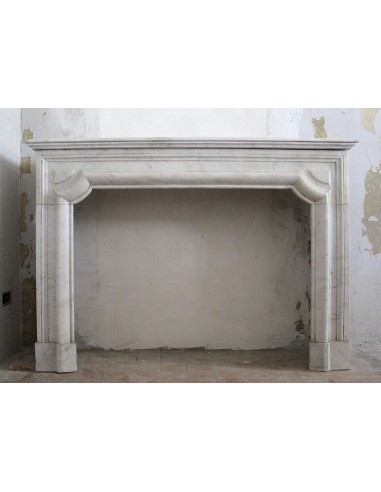Fascinating “Boudin Carré” fireplace mantel with shelled corners in White Carrara marble of “P” quality (the letter P stands for PURO), construction period 1840/60, provenance Côte d'Azur.
Since this model (CARRE') of the most important French builder of the 19th century is definitely rare, I could not resist publishing it in the state of the find, without waiting for the normal pre-publication restoration... Mind you, it's not that our fireplace is in disrepair, but you will understand, too, that maybe after a century and a half of life even HE will have some signs of old age, and if we were to present it after offering it some makeover, well, maybe it would be better..
My son Enrico will be angry (so to speak, after all he is much more sensible than I am) and will say something to me about this decision of mine, but patience, I think I did the right thing, I know from experience that this model, as elegant as it is minimalist will soon find an amateur and then we will restore it for him ante delivery...
Important: This fireplace is French and, contrary to 99% of the fireplaces published here, it is also of French sculpture, yet this model was born in Italy, in Naples in the mid-1800s, sprung from the imagination of the great painter Salvator Rosa, misunderstood in Italy as much as appreciated beyond the Alps. But more on this story, perhaps, if you come to see it de visu.
ECOLOGY AND ANTIQUE FIREPLACES
There is a lot of talk about ecology issues, the need to maintain some environmental harmony before running into total disaster, well, even the choice of an antique fireplace instead of one of modern industrial production can make its small contribution to this cause.
Why, you may ask?
But because an antique fireplace is made of a marble or stone that has already been quarried, and therefore does not need newly quarried materials... Our Apuan Alps, already so disrupted by millennia of quarrying, certainly do not need any more scarring, and so for all those extractive situations everywhere, wildly (especially in the so-called “emerging” countries..) disfigured in their appearance and morphology with the inevitable hydrogeological consequences.
Another "ecological" point in favor of the antique fireplace lies in the fact that antique fireplaces were assembled with entirely natural materials (especially plaster) and not with plastic or silicone mastics as is the case today. Their carving, then, was entirely manual, and did not produce the waste sewage that modern machines spit out with each piece and which we then, perhaps, find ourselves illegally dumped into the sea or into some disused quarry given the high cost of their disposal by law
Think about it folks, think about it...






































































